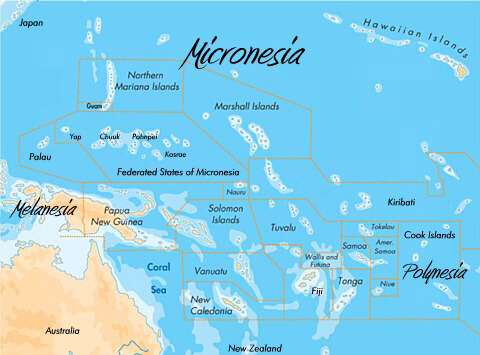

There are also about 3,000 speakers of Kapingamarangi and Ulithian, and under 1,000 speakers of Nukuoro. The languages of the Federated States of Micronesia include English (the official and common language), Trukese, Pohnpeian, Yapese, Kosraean. Approximately 6,500 of them are scattered around the island. Their value is based on both size and history, many of them having been brought from other islands, as far as New Guinea, but most coming in ancient times from Palau. There are five major types: Mmbul, Gaw, Ray, Yar, and Reng, the last being only 1 foot (0.3 m) in diameter. The islanders, aware of the owner of a piece, do not necessarily move them when ownership changes. The island of Yap is notable for its "stone money" (Rai stones), large disks usually of calcite, up to 12 feet (4 m) in diameter, with a hole in the middle. For example, cultural similarities like the importance of the traditional extended family and clan systems can be found on all the islands. Yap International Airport located in the main island of the state of YapĮach of the four States has its own culture and traditions, but there are also common cultural and economic bonds that are centuries old. Kosrae International Airport located in the main island of the state of Kosrae Pohnpei International Airport in the main island of the state of PohnpeiĬhuuk International Airport located in the main island of the state of Chuuk The Federated States of Micronesia is served by four international airports: Geographical isolation and a poorly developed infrastructure are major impediments to long-term growth. Financial assistance from the US is the primary source of revenue, with the US pledged to spend $1.3 billion in the islands in 1986–2001. The potential for a tourist industry exists, but the remoteness of the location and a lack of adequate facilities hinder development. Long line tuna fishing is also viable with foreign vessels from China operated in the 1990s. The islands have few mineral deposits worth exploiting, except for high-grade phosphate. The Compact was renewed in 2004.Įconomic activity in the Federated States of Micronesia consists primarily of subsistence farming and fishing.
#Micronesia capital island free
The FSM signed a Compact of Free Association with the United States of America, which entered into force on November 3, 1986, marking Micronesia's emergence from trusteeship to independence. Palau, the Marshall Islands, and the Northern Mariana Islands chose not to participate.


On May 10, 1979, four of the Trust Territory districts ratified a new constitution to become the Federated States of Micronesia. In February 1944, Operation Hailstone, one of the most important naval battles of the war, took place at Truk, in which many Japanese support vessels It was sold to Germany in 1899, conquered by Japan in 1914, before being seized by the United States during World War II and administered by the US under United Nations auspices in 1947 as part of the Trust Territory of the Pacific Islands.ĭuring World War II, a significant portion of the Japanese fleet was based in Truk Lagoon. It is located near the island of Pohnpei and used to be the ceremonial and political seat of the Saudeleur dynasty that united Pohnpei's estimated 25,000 people from about AD 500 until 1500, when the centralized system collapsed.Įuropean explorers - first the Portuguese in search of the Spice Islands (Indonesia) and then the Spanish - reached the Carolines in the sixteenth century, with the Spanish establishing sovereignty.
#Micronesia capital island series
Nan Madol, consisting of a series of small artificial islands linked by a network of canals, is often called the Venice of the Pacific. The ancestors of the Micronesians settled over four thousand years ago.Ī decentralized chieftain-based system eventually evolved into a more centralized economic Yap Colonia: Land Area: 118 sq km Population: 16,436 95 Density: 95 per sq km Pohnpei Kolonia: Land Area: 346 sq km Population: 74,685 Density: 100 per sq km Kosrae Tofol: Land Area: 110 sq km Population: 9,686 Density: 70 per sq km It is a sovereign state in free association with the United States.Ĭhuuk Weno: Land Area: 127 sq km Population: 54 595 Density: 420 per sq km Population: 155 400 Chuukese 48.8%, Pohnpeian 24.2%, Kosraean 6.2%, Yapese 5.2%,Īn island nation located in the Pacific Ocean, north of New Guinea. The other languages spoken in the country are Pingelapese, Ngatikese, Satawalese, Kapingamarangi Language, Nukuoro Language, Puluwatese, Mortlockese, and Mokilese. Languages: English, Ulithian, Woleaian, Yapese, Pohnpeian, Kosraean, and Chuukese - seven official languages. Official name: The Federated States of Micronesia


 0 kommentar(er)
0 kommentar(er)
